 Software Tutorial
Software Tutorial
 Computer Software
Computer Software
 How to use the vlookup function-How to use the vlookup function
How to use the vlookup function-How to use the vlookup function
How to use the vlookup function-How to use the vlookup function
php editor Xiaoxin will give you an in-depth understanding of how to use the vlookup function. The vlookup function is a commonly used search function in Excel, which can help users find the location of specific values in the table. Mastering the skills of using the vlookup function can improve the efficiency of data processing and make work more convenient. Flexible use of the vlookup function in Excel can easily achieve data search and matching, improving work efficiency. Want to know more detailed usage of vlookup function? Next, let’s dive into it!
1. Accurate search
According to the precise information, query the corresponding data in the data table. In the figure, you can check the student ID by name, and use "=VLOOKUP(F3,A1:D5,4,0)".
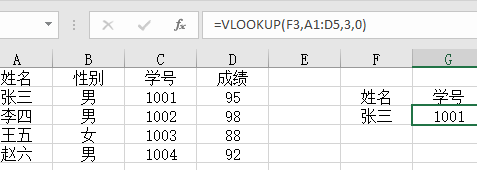
2. Search with multiple conditions
If there is duplicate data in the table, conditions must be added to limit the query. The formula used to find Class 2 Li Bai in the picture is "=VLOOKUP(F5&G5,IF({1,0},A3:A11&B3:B11,D3:D11),2,FALSE)".
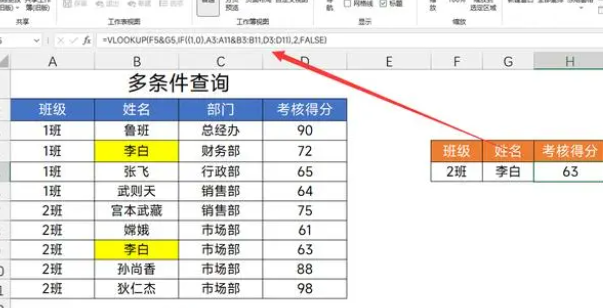
3. Reverse search
We want to use VLOOKUP to query Li Bai's job number, which is a reverse search. Find the job number on the left through the known name. The formula is "=VLOOKUP(F5,IF({1,0},B3:B11,A3: A11),2,FALSE)".
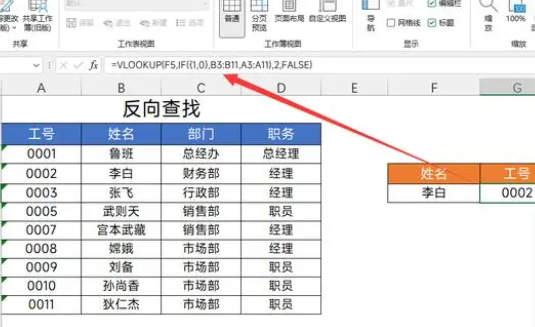
4. One-to-many query
One piece of information matches multiple employees, and you can check the employee names by part. The picture takes the marketing department as an example to query the names of all employees in the marketing department. The formula is "=IFERROR(VLOOKUP(ROW(A1),$A$2:$E$11,4 ,0),"")".
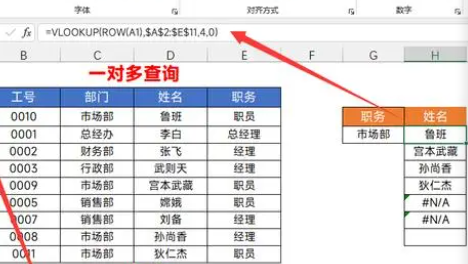
5. Automatically match the third parameter
Using one function, you can get multiple rows and columns of data. You can query the department and name through the employee number. The formula is "=VLOOKUP($F3,$A$2:$D$13,MATCH(H$2,$A$2:$ D$2,0),FALSE)”
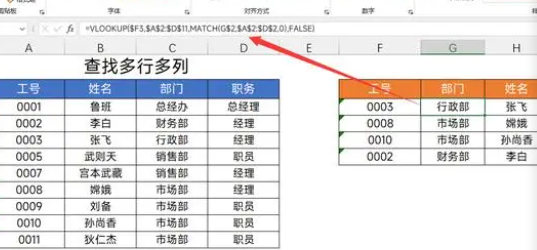
6. Wildcard search
Wildcards are commonly used symbols
?: represents any 1 character
*: represents any number of characters
We can use wildcards to perform fuzzy searches. This is used when your information memory is fuzzy. If you don’t know the name, you can use this method to query. The formula in the picture is "=VLOOKUP(F4,B3:C11,2,0)".
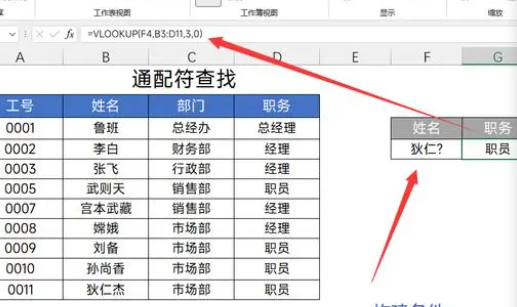
7. Interval query
Interval query needs to build an interval first. The green marked data table in the figure is an interval. At this time, you can query the corresponding commission. However, please note that the fourth parameter is 1. The formula is "=VLOOKUP(B4,$E$11:$F$16 ,2,TRUE)”.
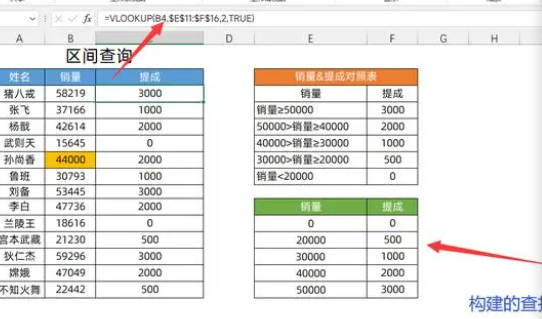
8. Data extraction
Obtain data from a bunch of characters, exclude non-numeric content, and identify valid information. The formula is "=VLOOKUP(0,MID(A3,ROW($1:$102),11)*{0,1},2,FALSE) ".
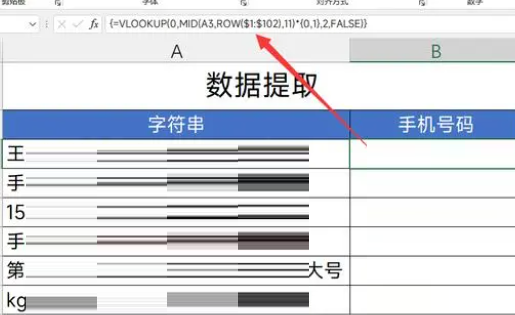
9. Find the maximum/nearest value
When looking for the maximum and minimum sales on a certain day, first use the "Sort" tool to "sort in descending order", and then use the formula "=VLOOKUP(F3,A2:C14,3,0)".
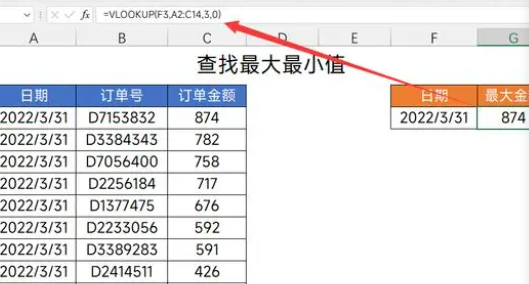
10. Skip empty character search
If there are spaces in the string, the result #N/A will be returned. In this case, you need to use the TRIM function to clear the spaces in the text, and then query the data. In the data table with spaces, query Zhang 3's basic salary. The formula is "=VLOOKUP(TRIM( G2),TRIM(B1:E6),4,FALSE)".
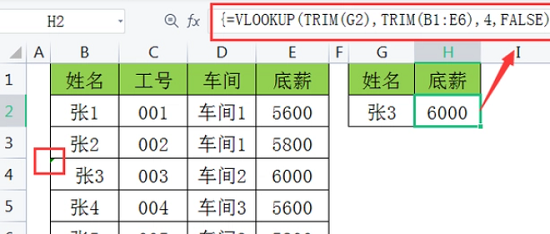
11. Merge cell query
To merge data in different cells for query, you need to use the "INDIRECT" function to jump. The picture shows that when the name is known, the data is unified to query the results of Li Bai in class 2. The formula is "=VLOOKUP(G5,INDIRECT( "b"&MATCH(F5,A:A,0)&":D11"),3,0)".
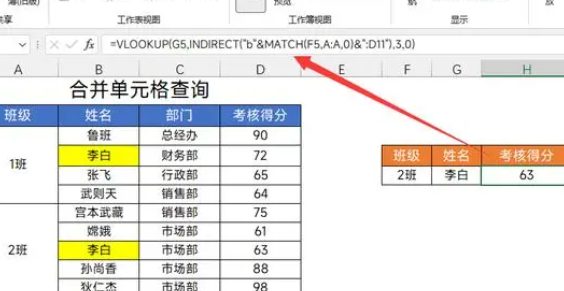
The above is all the tutorials on how to use the vlookup function that the editor has brought to you. I hope it can be helpful to you.
The above is the detailed content of How to use the vlookup function-How to use the vlookup function. For more information, please follow other related articles on the PHP Chinese website!

Hot AI Tools

Undresser.AI Undress
AI-powered app for creating realistic nude photos

AI Clothes Remover
Online AI tool for removing clothes from photos.

Undress AI Tool
Undress images for free

Clothoff.io
AI clothes remover

AI Hentai Generator
Generate AI Hentai for free.

Hot Article

Hot Tools

Notepad++7.3.1
Easy-to-use and free code editor

SublimeText3 Chinese version
Chinese version, very easy to use

Zend Studio 13.0.1
Powerful PHP integrated development environment

Dreamweaver CS6
Visual web development tools

SublimeText3 Mac version
God-level code editing software (SublimeText3)

Hot Topics
 1378
1378
 52
52
 Tips for dynamically creating new functions in golang functions
Apr 25, 2024 pm 02:39 PM
Tips for dynamically creating new functions in golang functions
Apr 25, 2024 pm 02:39 PM
Go language provides two dynamic function creation technologies: closure and reflection. closures allow access to variables within the closure scope, and reflection can create new functions using the FuncOf function. These technologies are useful in customizing HTTP routers, implementing highly customizable systems, and building pluggable components.
 Considerations for parameter order in C++ function naming
Apr 24, 2024 pm 04:21 PM
Considerations for parameter order in C++ function naming
Apr 24, 2024 pm 04:21 PM
In C++ function naming, it is crucial to consider parameter order to improve readability, reduce errors, and facilitate refactoring. Common parameter order conventions include: action-object, object-action, semantic meaning, and standard library compliance. The optimal order depends on the purpose of the function, parameter types, potential confusion, and language conventions.
 How to write efficient and maintainable functions in Java?
Apr 24, 2024 am 11:33 AM
How to write efficient and maintainable functions in Java?
Apr 24, 2024 am 11:33 AM
The key to writing efficient and maintainable Java functions is: keep it simple. Use meaningful naming. Handle special situations. Use appropriate visibility.
 Complete collection of excel function formulas
May 07, 2024 pm 12:04 PM
Complete collection of excel function formulas
May 07, 2024 pm 12:04 PM
1. The SUM function is used to sum the numbers in a column or a group of cells, for example: =SUM(A1:J10). 2. The AVERAGE function is used to calculate the average of the numbers in a column or a group of cells, for example: =AVERAGE(A1:A10). 3. COUNT function, used to count the number of numbers or text in a column or a group of cells, for example: =COUNT(A1:A10) 4. IF function, used to make logical judgments based on specified conditions and return the corresponding result.
 Comparison of the advantages and disadvantages of C++ function default parameters and variable parameters
Apr 21, 2024 am 10:21 AM
Comparison of the advantages and disadvantages of C++ function default parameters and variable parameters
Apr 21, 2024 am 10:21 AM
The advantages of default parameters in C++ functions include simplifying calls, enhancing readability, and avoiding errors. The disadvantages are limited flexibility and naming restrictions. Advantages of variadic parameters include unlimited flexibility and dynamic binding. Disadvantages include greater complexity, implicit type conversions, and difficulty in debugging.
 What are the benefits of C++ functions returning reference types?
Apr 20, 2024 pm 09:12 PM
What are the benefits of C++ functions returning reference types?
Apr 20, 2024 pm 09:12 PM
The benefits of functions returning reference types in C++ include: Performance improvements: Passing by reference avoids object copying, thus saving memory and time. Direct modification: The caller can directly modify the returned reference object without reassigning it. Code simplicity: Passing by reference simplifies the code and requires no additional assignment operations.
 What is the difference between custom PHP functions and predefined functions?
Apr 22, 2024 pm 02:21 PM
What is the difference between custom PHP functions and predefined functions?
Apr 22, 2024 pm 02:21 PM
The difference between custom PHP functions and predefined functions is: Scope: Custom functions are limited to the scope of their definition, while predefined functions are accessible throughout the script. How to define: Custom functions are defined using the function keyword, while predefined functions are defined by the PHP kernel. Parameter passing: Custom functions receive parameters, while predefined functions may not require parameters. Extensibility: Custom functions can be created as needed, while predefined functions are built-in and cannot be modified.
 C++ Function Exception Advanced: Customized Error Handling
May 01, 2024 pm 06:39 PM
C++ Function Exception Advanced: Customized Error Handling
May 01, 2024 pm 06:39 PM
Exception handling in C++ can be enhanced through custom exception classes that provide specific error messages, contextual information, and perform custom actions based on the error type. Define an exception class inherited from std::exception to provide specific error information. Use the throw keyword to throw a custom exception. Use dynamic_cast in a try-catch block to convert the caught exception to a custom exception type. In the actual case, the open_file function throws a FileNotFoundException exception. Catching and handling the exception can provide a more specific error message.



